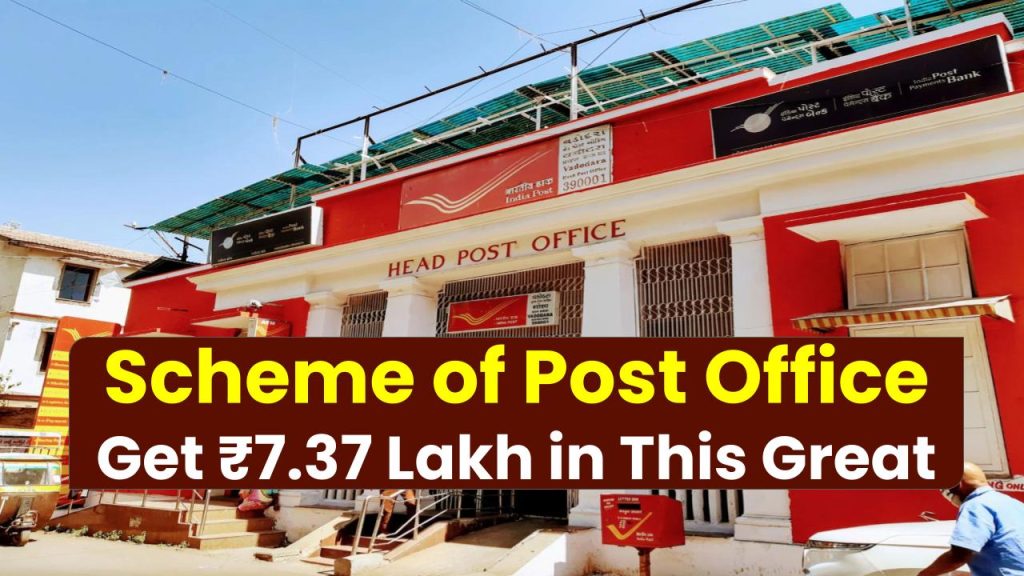
The Post Office offers many reliable and government-backed savings schemes, but one that stands out for its consistent returns and disciplined savings model is the Post Office Recurring Deposit (RD) Scheme. If you’re looking for a way to grow your money safely and steadily, the Post Office RD scheme may be the answer. In this article, we’ll explain how depositing ₹10,000 per month can fetch you ₹7.37 lakh, complete with real examples, official data, and expert-backed advice.
The Post Office RD scheme is a great option for salaried individuals, small business owners, parents planning for their child’s education, or anyone who wants to build a large corpus through small monthly investments.
Great Scheme of Post Office
| Feature | Details |
|---|---|
| Scheme Name | Post Office Recurring Deposit (RD) Scheme |
| Monthly Investment | ₹10,000 |
| Tenure | 5 years (60 months) |
| Interest Rate (as of April 2025) | 6.7% per annum (compounded quarterly) |
| Total Investment | ₹6,00,000 |
| Maturity Amount | ₹7,13,659 approx. |
| Total Interest Earned | ₹1,13,659 approx. |
| Premature Closure | Allowed after 3 years with interest adjustment |
| Loan Facility | Available after 12 deposits |
| Official Website | India Post |
The Post Office RD Scheme offers a powerful way to build wealth through disciplined savings. By depositing just ₹10,000 a month, you could walk away with over ₹7 lakh in 5 years. It’s simple, safe, and backed by the Government of India—making it a dependable option for individuals of all ages. Whether you’re saving for a wedding, education, a new house, or just building a financial cushion, this scheme is worth serious consideration.
What is the Post Office RD Scheme?
The Post Office RD Scheme is a small savings scheme launched by the Government of India, aimed at helping individuals cultivate a habit of regular savings. Under this scheme, a fixed amount is deposited every month for a period of 5 years. The interest is compounded quarterly, which helps the deposit grow significantly over time.
This scheme is one of the most preferred saving instruments for risk-averse investors who want guaranteed returns with no exposure to market fluctuations.
Why It Stands Out:
- Guaranteed returns backed by the Government of India
- Quarterly compounding leads to better accumulation
- Suitable for short- to mid-term goals
- Easy to open and operate through India Post branches
see also: This Bank is Offering the Cheapest Home Loan
How You Get ₹7.37 Lakh by Investing ₹10,000 Monthly
Let’s break it down with a real-life example.
Assumptions:
- You deposit ₹10,000 every month
- Tenure is fixed at 5 years
- Current RD interest rate: 6.7% per annum, compounded quarterly
Calculation:
- Total Principal Invested: ₹10,000 x 60 months = ₹6,00,000
- Interest Earned: Approximately ₹1,13,659
- Total Maturity Amount: ₹7,13,659
That means your money grows by over ₹1.13 lakh just through disciplined monthly saving.
Note: Some sources may round up this amount to ₹7.37 lakh, accounting for minor interest variations or compounding effects based on exact deposit dates.
Features and Benefits
1. Safe and Secure
This scheme is operated by the Department of Posts under the Ministry of Communications, ensuring complete security and government backing.
2. Quarterly Compounding
Interest is calculated every three months, which significantly increases the total yield over time.
3. Loan Facility
After depositing for 12 months, you can take a loan of up to 50% of the balance without breaking the RD.
4. Premature Withdrawal
Allowed after 3 years but with reduced interest. Ideal only in emergencies.
5. No TDS Deduction
Unlike bank FDs, there is no TDS deduction on RD interest. However, you need to declare interest earned in your ITR.
Who Should Consider This Scheme?
This scheme is ideal for:
- Salaried Individuals: Save a part of monthly income consistently.
- Parents: Build a fund for child’s education or marriage.
- Self-Employed Professionals: Enjoy fixed returns without market risk.
- Senior Citizens: Prefer safe investments over volatile options.
If you’re looking to build a corpus of over ₹7 lakh in 5 years through systematic savings, this is a practical route.
How to Open a Post Office RD Account
Here’s a step-by-step guide:
Step 1: Visit Your Nearest Post Office
Go to your local India Post branch with the required documents.
Step 2: Fill Out the RD Account Opening Form
Available at the post office or downloadable from the official website.
Step 3: Submit KYC Documents
- Aadhaar Card
- PAN Card
- Passport-size Photograph
- Address Proof
Step 4: Deposit the First Installment
Minimum ₹100 (in multiples of ₹10 thereafter)
Step 5: Get Your Passbook
This will serve as the official record of your monthly deposits and interest.
You can also open an RD account via India Post Payments Bank (IPPB) mobile app if you have a savings account.
Tax Implications
While no TDS is deducted on RD interest, it is fully taxable as per your income tax slab. You must report the total interest earned under ‘Income from Other Sources’ when filing your ITR.
There is no Section 80C benefit on RD deposits. If you’re looking for tax-saving options, consider schemes like PPF or NSC.
see also: File Income Tax Return in Just a Few Minutes from Home
Comparison with Similar Schemes
| Scheme | Interest Rate | Lock-in Period | Tax Benefit | Risk |
|---|---|---|---|---|
| Post Office RD | 6.7% | 5 years | No | Very Low |
| Bank RD | Varies (5.5% to 7.5%) | 1-10 years | No | Low |
| PPF | 7.1% | 15 years | Yes (80C) | Very Low |
| NSC | 7.7% | 5 years | Yes (80C) | Very Low |
Great Scheme of Post Office FAQs
Q1. Can I change the monthly deposit amount midway?
No. Once fixed, the monthly deposit amount remains unchanged for the tenure.
Q2. What happens if I miss a monthly payment?
A default fee of ₹1 per ₹100 per month is charged. If you miss 4 consecutive deposits, the account will be discontinued.
Q3. Can I extend my RD after 5 years?
No, the standard RD tenure is 5 years. However, you can start a new RD after maturity.
Q4. Is there a nomination facility?
Yes, you can nominate a person while opening the RD account.
Q5. Can minors open an RD account?
Yes. Minors aged 10 years and above can open an account in their name. For younger children, parents/guardians can open on their behalf.











